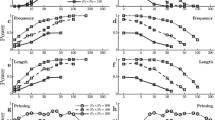Abstract
Recent theories have stressed the role of effect anticipation in action control. Such a mechanism requires the prior acquisition of integrated action-effect associations. The strength of such associations should directly depend on the amount of learning, and therefore be most pronounced in motor experts. Using an interference paradigm, we investigated whether evidence of such representations can be demonstrated in expert pianists. Participants were required to play chords on a keyboard in response to imperative visual stimuli. Concurrently, task-irrelevant auditory stimuli (“potential” action effects) were presented that were congruent or incongruent with the chords to be played. In Experiment 1 we found evidence that expert pianists, compared with non-musicians, have acquired such action-effects representations. Response times were slower when the auditory stimulus was incongruent with the required response. In order to ascertain the locus of interference, we varied imperative stimuli and responses in Experiments 2 and 3. The results indicate that, for the most part, interference occurs on the response level rather than on an abstract level. However, the perception of action effects also evokes processing of abstract features, like the concept of major–minor mode.

Similar content being viewed by others
References
Allard, F., Deakin, J., Parker, S., & Rodgers, W. (1993). Declarative knowledge in skilled motor performance: Byproduct or constituent? In J. L. Starkes & F. Allard (Eds.), Cognitive issues in motor expertise (Vol. 102, pp. 95–107). Amsterdam: North-Holland.
Bangert, M., & Altenmüller, E. O. (2003). Mapping perception to action in piano practice: a longitudinal DC-EEG study. BMC Neuroscience, 4, 26–36.
Brass, M., Bekkering, H., Wohlschläger, A., & Prinz, W. (2000). Compatibility between observed and executed finger movements: Comparing symbolic, spatial, and imitative cues. Brain and Cognition, 44, 124–143.
Chaffin, R., & Imreh, G. (2002). Practicing perfection: Piano performance as expert memory. Psychological Science, 13, 342–349.
Cohen, J. (1988). Statistical power analysis for the behavioral sciences (2nd ed.). Hillsdale, NJ: Lawrence Erlbaum.
Elsner, B., & Hommel, B. (2001). Effect anticipation and action control. Journal of Experimental Psychology: Human Perception and Performance, 27, 229–240.
Elsner, B., Hommel, B., Mentschel, C., Drzezga, A., Prinz, W., Conrad, B., & Siebner, H. (2002). Linking actions and their perceivable consequences in the human brain. Neuroimage, 17, 364–372.
Ericsson, K. A., Krampe, R. T., & Tesch-Romer, C. (1993). The role of deliberate practice in the acquisition of expert performance. Psychological Review, 100, 363–406.
Haueisen, J., & Knösche, T. R. (2001). Involuntary motor activity in pianists evoked by music perception. Journal of Cognitive Neuroscience, 13, 786–792.
Koch, I., & Kunde, W. (2002). Verbal response-effect compatibility. Memory & Cognition, 30, 1297–1303.
Kornblum, S., & Lee, J. W. (1995). Stimulus response compatibility with relevant and irrelevant stimulus dimensions that do and do not overlap with the response. Journal of Experimental Psychology: Human Perception & Performance, 21, 855–875.
Kunde, W. (2001). Response-effect compatibility in manual choice reaction tasks. Journal of Experimental Psychology: Human Perception & Performance, 27, 387–394.
Nakada, T., Fujii, Y., Suzuki, K., & Kwee, I. L. (1998). ‘Musical brain’ revealed by high-field (3 Tesla) functional MRI. Neuroreport, 9, 3853–3856.
Palmer, C. (1997). Music performance. Annual Review of Psychology, 48, 115–138.
Palmer, C., & Meyer, R. K. (2000). Conceptual and motor learning in music performance. Psychological Science, 11, 63–68.
Schon, D., Anton, J. L., Roth, M., & Besson, M. (2002). An fMRI study of music sight-reading. Neuroreport, 13, 2285–2289.
Segalowitz, S. J., Bebout, L. J., & Lederman, S. J. (1979). Lateralization for reading musical chords: disentangling symbolic, analytic, and phonological aspects of reading. Brain & Language, 8, 315–323.
Sloboda, J. A. (2000). Individual differences in music performance. Trends in Cognitive Sciences, 4, 397–403.
Stürmer, B., Aschersleben, G., & Prinz, W. (2000). Correspondence effects with manual gestures and postures: A study of imitation. Journal of Experimental Psychology: Human Perception & Performance, 26, 1746–1759.
Acknowledgements
We thank Sonja Herberth for conducting the experiments and Birgit Elsner for the original inspiration for this study. We are also grateful to Wilfried Kunde and Bruno Repp for their helpful comments on an earlier draft of this article.
Author information
Authors and Affiliations
Corresponding author
Rights and permissions
About this article
Cite this article
Drost, U.C., Rieger, M., Brass, M. et al. Action-effect coupling in pianists. Psychological Research 69, 233–241 (2005). https://doi.org/10.1007/s00426-004-0175-8
Received:
Accepted:
Published:
Issue Date:
DOI: https://doi.org/10.1007/s00426-004-0175-8




